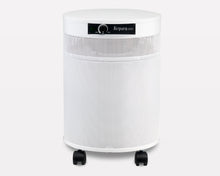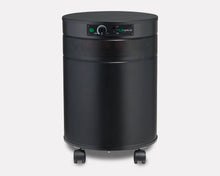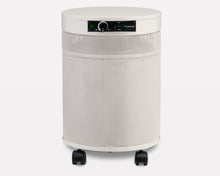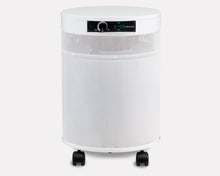UV-C Air Purification: The Science Behind Cleaner Indoor Air

Indoor air can be up to five times more polluted than outdoor air, according to the Environmental Protection Agency. If you've been researching air purification solutions, you've likely encountered terms like HEPA filtration and UV-C light technology. While both approaches tackle indoor air quality, they work in fundamentally different ways—and understanding these differences can help you make informed decisions about protecting your family's health.
This comprehensive guide explores how UV-C technology works, its effectiveness compared to traditional HEPA filtration, and why airflow rates matter more than you might think when choosing an air purification system.
The Hidden Reality of Indoor Air Pollution
Most people assume the air inside their homes is cleaner than what's outside, but research consistently proves otherwise. The EPA estimates that indoor air pollution levels can be two to five times higher than outdoor levels, with some pollutants reaching concentrations up to 100 times higher indoors.
This concentration happens because modern homes are built to be energy-efficient, creating tightly sealed environments where pollutants accumulate. Common indoor air contaminants include volatile organic compounds (VOCs) from furniture and cleaning products, biological pollutants like bacteria and viruses, allergens such as dust mites and pet dander, and particulate matter from cooking and outdoor infiltration.
The health implications extend beyond minor discomfort. Poor indoor air quality contributes to respiratory issues, allergies, headaches, and fatigue. For vulnerable populations—including children, elderly individuals, and those with compromised immune systems—contaminated indoor air can trigger serious health complications.
Understanding UV-C Technology: Nature's Disinfection Method
What Is UV-C Light?
Ultraviolet-C (UV-C) light represents the most energetic portion of the ultraviolet spectrum, with wavelengths between 200 and 280 nanometers. Unlike UV-A and UV-B rays that reach Earth's surface, UV-C radiation is naturally filtered out by our atmosphere's ozone layer. This makes UV-C particularly lethal to microorganisms that haven't evolved defenses against this type of radiation.
The germicidal properties of UV-C light were first discovered in the late 1800s, and by the 1930s, UV-C disinfection was being used in hospitals and water treatment facilities. The technology works by damaging the DNA and RNA of microorganisms, preventing them from reproducing and effectively neutralizing them.
The Science Behind UV-C Disinfection
When UV-C photons strike microorganisms, they penetrate the cell walls and disrupt the genetic material within. Specifically, UV-C light causes adjacent thymine bases in DNA strands to bond together, creating thymine dimers. These molecular changes prevent the organism from replicating, effectively sterilizing it without the use of chemicals.
Research published in the Journal of Hospital Infection demonstrates that UV-C light can achieve a 99.9% reduction in airborne bacteria, viruses, and mold spores when properly applied. The effectiveness depends on several factors: the intensity of the UV-C light, the duration of exposure, the distance from the light source, and the specific type of microorganism.
Different pathogens require different levels of UV-C exposure, measured in microwatts per square centimeter multiplied by seconds (μW·s/cm²). For example, common bacteria like Staphylococcus aureus requires approximately 4,500 μW·s/cm² for 90% inactivation, while more resistant organisms may need higher doses.
UV-C in Air Purification Systems
Modern air purifiers integrate UV-C technology in several ways. Some systems place UV-C lamps within the airflow path, exposing contaminants to germicidal radiation as air passes through the unit. Others combine UV-C with photocatalytic oxidation, using titanium dioxide catalysts to enhance the disinfection process and break down chemical pollutants.
The key advantage of UV-C technology is its ability to neutralize living contaminants that traditional filtration might miss. While filters physically trap particles, UV-C actively destroys the biological threats, preventing them from reproducing even if they escape the filtration system.
HEPA Filtration: The Gold Standard for Particle Removal
How HEPA Filters Work
High-Efficiency Particulate Air (HEPA) filters operate on three distinct mechanisms: impaction, interception, and diffusion. Larger particles are captured through impaction when they collide directly with filter fibers. Medium-sized particles are caught through interception when they pass close enough to fibers to be captured. The smallest particles are captured through diffusion, where Brownian motion causes tiny particles to move erratically and eventually contact filter fibers.
True HEPA filters must remove at least 99.97% of particles that are 0.3 micrometers in diameter—the most penetrating particle size. This standard, established by the Department of Energy, ensures consistent performance across different manufacturers and applications.
HEPA vs. UV-C: Complementary Technologies
While both technologies improve indoor air quality, they address different types of contaminants through distinct mechanisms. HEPA filtration excels at removing particulate matter including dust, pollen, pet dander, and smoke particles. The physical barrier created by HEPA filters captures these contaminants regardless of whether they're living or non-living.
UV-C technology, conversely, specializes in neutralizing biological contaminants. Bacteria, viruses, mold spores, and other microorganisms are effectively sterilized by UV-C radiation, but the technology has limited impact on non-biological particles or chemical pollutants.
A study published in Building and Environment found that combining HEPA filtration with UV-C technology provided superior air quality improvements compared to either technology alone. The hybrid approach captured particulate matter while simultaneously sterilizing biological contaminants, creating a more comprehensive air purification solution.
The Critical Role of Airflow in Air Purification
Understanding Air Changes Per Hour (ACH)
Airflow rate fundamentally determines how effectively any air purification technology performs in real-world conditions. The concept of Air Changes Per Hour (ACH) measures how many times the complete volume of air in a room is processed by the purification system within one hour.
For example, a room with 1,000 cubic feet of air space served by a purifier moving 500 cubic feet per minute (CFM) would achieve 30 air changes per hour (500 CFM × 60 minutes ÷ 1,000 cubic feet = 30 ACH). Higher ACH rates generally correlate with better air quality outcomes, but the relationship isn't linear.
The Contact Time Equation
The effectiveness of both HEPA filtration and UV-C disinfection depends heavily on contact time—how long contaminants remain within the purification zone. For HEPA filters, this means ensuring adequate residence time for particles to encounter filter fibers. For UV-C systems, sufficient exposure time is crucial for achieving the necessary germicidal dose.
Research from the International Journal of Environmental Research and Public Health reveals that air purifiers operating at extremely high airflow rates may actually reduce purification efficiency. When air moves too quickly through the system, particles have insufficient time to be captured by HEPA filters, and microorganisms receive inadequate UV-C exposure for complete sterilization.
Balancing Speed and Effectiveness
The optimal airflow rate balances rapid air circulation with adequate contact time for purification. Most effective air purifiers operate within specific airflow ranges that maximize both coverage and treatment efficacy. Units that move air too slowly fail to address room-wide contamination quickly enough, while those operating at excessive speeds compromise treatment quality.
Professional-grade air purifiers often include variable speed controls, allowing users to adjust airflow rates based on room size, contamination levels, and specific air quality goals. During high-pollution periods, slower speeds may provide more thorough purification, while faster speeds can quickly address sudden contamination events.
Practical Applications and Real-World Performance
Clinical and Commercial Success
Healthcare facilities have extensively validated UV-C air purification technology. A comprehensive study published in the American Journal of Infection Control documented a 35% reduction in healthcare-associated infections when UV-C air purification was implemented in hospital rooms. The technology proved particularly effective against airborne pathogens that traditional cleaning methods couldn't address.
Commercial applications have shown similar success rates. Office buildings using combined HEPA and UV-C systems reported improved employee health outcomes and reduced sick leave rates. The technology's ability to continuously sterilize circulating air provides ongoing protection that complements other infection control measures.
Residential Implementation Considerations
For home use, the effectiveness of UV-C technology depends on proper sizing and installation. Systems must be appropriately matched to room volumes, with adequate airflow rates to ensure comprehensive coverage. Safety considerations are paramount, as direct exposure to UV-C light can cause skin and eye irritation.
Modern residential air purifiers incorporate safety features including enclosed UV-C chambers and automatic shutoffs that prevent accidental exposure. These designs allow homeowners to benefit from germicidal technology without safety risks associated with direct UV-C exposure.
Making Informed Air Purification Decisions
Choosing the Right Technology
The choice between HEPA filtration, UV-C technology, or combined systems depends on specific air quality concerns and environmental factors. Homes with high particulate pollution from nearby traffic or construction sites may benefit most from robust HEPA filtration. Environments with high biological contamination risks—such as homes with immune-compromised residents—may prioritize UV-C sterilization capabilities.
Many experts recommend hybrid systems that combine multiple technologies for comprehensive air quality improvement. These systems address both particulate and biological contaminants while providing flexibility to adjust treatment priorities based on changing conditions.
Implementation Best Practices
Regardless of technology choice, proper implementation is crucial for optimal performance. Air purifiers should be sized appropriately for target spaces, positioned to maximize air circulation, and maintained according to manufacturer specifications. Regular filter replacement and UV-C lamp maintenance ensure consistent performance over time.
Professional air quality testing can help identify specific contaminants and guide technology selection. Indoor air quality monitors provide ongoing feedback about system performance and help optimize settings for changing conditions.
The Future of Indoor Air Quality
As our understanding of indoor air pollution continues to evolve, air purification technologies are becoming more sophisticated and targeted. Emerging research on ultra-fine particles, chemical pollutants, and biological contaminants is driving innovation in filtration and sterilization methods.
The integration of smart sensors, automated controls, and real-time air quality monitoring is making professional-grade air purification more accessible to residential users. These advances promise more effective, efficient, and user-friendly solutions for maintaining healthy indoor environments.
Key Takeaways for Cleaner Indoor Air
UV-C technology offers a powerful, chemical-free method for neutralizing biological contaminants in indoor air. When properly implemented with adequate airflow rates and contact time, UV-C systems can achieve high levels of pathogen inactivation. However, the technology works best as part of a comprehensive air quality strategy that may include HEPA filtration for particulate removal.
The relationship between airflow and purification effectiveness is critical—faster isn't always better when it comes to air purification. Systems must balance adequate coverage with sufficient contact time to achieve optimal results.
Whether you choose HEPA filtration, UV-C technology, or a combined approach, focus on systems that are properly sized for your space, professionally installed, and regularly maintained. The investment in quality air purification technology pays dividends in improved health, comfort, and peace of mind for you and your family.
Frequently Asked Questions
Q: Is UV-C air purification safe for home use? A: Modern UV-C air purifiers designed for residential use incorporate safety features that prevent direct exposure to UV-C light. The germicidal radiation is contained within enclosed chambers, making the technology safe for continuous operation in occupied spaces.
Q: How often do UV-C lamps need replacement? A: UV-C lamps typically require replacement every 12-18 months, depending on usage and manufacturer specifications. Lamp output gradually decreases over time, reducing germicidal effectiveness even when the lamp appears to be functioning normally.
Q: Can UV-C technology remove odors from indoor air? A: UV-C light has limited effectiveness against chemical odors and volatile organic compounds. For comprehensive odor control, consider systems that combine UV-C with activated carbon filtration or photocatalytic oxidation technology.
Q: What's the ideal room size for UV-C air purifiers? A: UV-C air purifier effectiveness depends on achieving adequate air changes per hour for the target space. Most residential units are rated for specific room sizes based on their airflow capacity and UV-C lamp output. Always choose units rated for your actual room size or larger.
Q: How can I tell if my air purifier is working effectively? A: Indoor air quality monitors can measure pollutant levels before and after purification system installation. Look for sustained reductions in particulate matter, biological contaminants, and other measured pollutants during system operation.
This article is based on current scientific research and industry standards as of May 2025. For specific health concerns or air quality issues, consult with qualified professionals who can assess your individual situation and recommend appropriate solutions.





